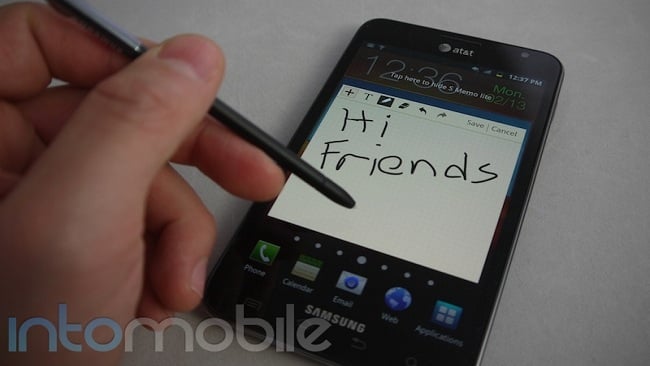We’re playing around with the Samsung Galaxy Note for At&T and our full review will be coming shortly, but I think we should show you what the deal is with that stylus or, as Samsung likes to call it, the S Pen.
Samsung says that this is one of the most advanced styluses in the world, as it’s pressure sensitive and can be used for a variety of uses. It fits nicely into the bottom of the Galaxy Note and you decide to never use it, the S Pen won’t detract from the physical design of the large handset. There’s also a pen holder that’s sold separately and it gives you a much larger, more pen-like experience.
As you would imagine, you can use this to scribble down some hand-written notes and there’s handwriting-translation software which will let you save your scribbles, as well as a typed out version. You can also use the S Pen to draw and this is where the pressure sensitivity kicks in, as pushing down harder on the screen will give you a different result than lightly penning the screen.
There are also a few system-wide gestures that you can do with the S Pen. Holding the pen’s button and double tapping on the screen will bring up the S Memo app to quickly jot down notes. Holding the button and swiping up will bring up the menu screen, swiping down will bring you to the home screen and swiping left is the equivalent of hitting the back button. When you hold the pen’s button and hold it on the screen, it will take a screenshot that you can then annotate or crop.
What’s interesting to me is that there’s already an S Pen SDK and roughly 20 apps which utilize the stylus – the Crayon Physics app that you see below shows you some of the potential. You just have to wonder if developers are going to bother though, as the Note is the only device that uses the S Pen but the stylus may make its way to Samsung’s tablets.
I’m still playing with the S Pen and the Galaxy Note for the in-depth review but I’m pretty convinced that I’m not the person who needs or wants this stylus. My handwriting is chicken scratch, I’m not artistic and I don’t see many cases where I’ll need to annotate a screen. Still, I know that artists and some students may see this differently, so I’ll let you watch the video below and make up your own minds.
